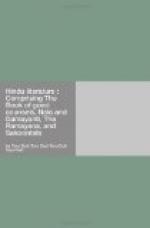The ideas of the human family are few, as is apparent from the study of the literature of widely different nations. Thus the “Ramayana” ranks in Hindoo with the “Iliad” and the “Odyssey” in Greek literature. The character of Rama corresponds with that of Menelaus, for both the European and the Asiatic heroes have had their wives carried off from them—although Sita, the bride of Rama, is chaste as an icicle from Diana’s temple, while Helen is the infamous type of wanton wives, ancient and modern. The Hindoo Lanka is Troy, and Ayodhya is Sparta. The material civilization of the cities in the Hindoo epic is more luxurious and gorgeous than that which Homer attributes to Greece in the heroic age. Such splendor and refinement as invests social life at Lanka and Ayodhya never appear amid the severe simplicity of Argos or Troy. The moral tone seems perhaps higher in India than in Greece during the periods described in their several epics—at least as far as mutual love and forbearance go—and the ideas of marriage and conjugal fidelity are equally exalted.
As to the literary quality of the Hindoo epic in comparison with Homer’s work, we are at once impressed with the immense superiority of the Greek poem in artistic proportion, point, and precision. The Hindoo poet flounders along, amid a maze of prolix description and wearisome simile. Trifles are amplified and repeated, and the whole poem resembles a wild forest abounding in rich tropical vegetation, palms and flowers, but without paths, roads, or limits. Or rather, we are reminded of one of the highly painted and richly decorated idols of India, with their many heads and many hands: but when we turn to the Greek epic we stand before a statue of pure outline, flawless proportions, and more than human beauty.
It is difficult to fix the date of the “Ramayana.” Scholars generally agree that it belongs to the third century before Christ, in its original form, but that some recent portions were added even during the Christian era. It is reckoned as one of the sacred books, and the study of it is supposed to bring forgiveness of sin, and prosperity. Its author is thought to have been the famous poet Valmiki, but the work has evidently been rehandled several times, and there are three versions of the poems still extant. The poem consists of twenty-four thousand verses, and the story of it—now overlaid as it is with extravagant and fabulous accretions—is evidently founded on fact. The scene of the poem is laid in the city of Ayodhya, the modern Oudh, which is described in glowing colors as a place of health, beauty, and prosperity—
“In by-gone ages built
and planned
By sainted Manu’s princely
hand.”
In the splendid palace of the Rajah, at Oudh, lives Dasaratha, mourning in childlessness. He is one of the princes descended from the sun, and his line now threatens to become extinct. He determines to appeal to the Gods by the Asva-medha, the great sacrifice in which a horse is the victim. The rites accordingly are performed with unparalleled magnificence, and, at the close of the ceremony, the high priest declares to the king—




